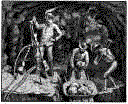
Cambria and the Cambria Fuel Company, Cambria, WY

|
|
Cambria and the Cambria Fuel Company, Cambria, WY |
|
At Cambria, Wyoming, on the western slope of the Black
Hills, one of the most interesting coal deposits and mining plants in the United States is owned and operated by the
Cambria Fuel Company.
When the projected transcontinental line of the Burlington and Missouri River
railroad, from Lincoln, Nebraska, to a connection with the Northern Pacific railroad at
Billings, Montana, reached Alliance, Nebraska, further construction was suspended until the railroad company felt assured of being able to obtain an ample supply of locomotive fuel in Nor' western Wyoming, as the proposed extension could not be profitably operated with coal from Iowa and eastern mines. With a view to securing a contract for building the road, the well-known firm of
Kilpatrick Bros. & Collins of Beatrice, Nebraska, placed several prospecting parties in the field, during 1887 and 1888, which succeeded in discovering what are now known as the
Cambria Coal Fields, and which are estimated, by the most conservative experts, to contain at least 40,000,000 tons of coal, particularly suitable for railroad locomotive service.
The deposit is unique in containing the only bituminous coking coal so far discovered in the state of Wyoming, and the
Cambria Fuel Company has apparently covered the entire area of available coal within the boundaries of the 17,000 acres of land comprising its property. The vein varies in thickness from four to ten feet, averaging about six feet, and has a slope to the southwest of about three degrees; it is cut by a number of deep ravines, which expose the coal seam at several places.
When the railroad company had, through its own experts, determined the quality and amount of the coal reserves to be satisfactory, contracts were made for extending the line westward from
Alliance, and Kilpatrick Bros. &
Collins undertook to open the mines, although operating at great disadvantage on account of being located so far from railroad facilities, and experiencing great difficulties in developing a water supply sufficient for the needs of a large mining plant and the railroad locomotives. Necessary machinery for the
initial installation was hauled with teams, about 170 miles from Alliance, but when the last rail was laid up the canon from
Newcastle, on December 4, 1889, the mines were prepared to furnish a regular supply of fuel. Since that time a steady and increasing production has been maintained, and up to December 31, 1903,
5,719,000 tons of coal had been mined, of which the Burlington used 4,160,000 tons.
Experts describe this plant as the most interesting type of mechanically operated coal mines in this country. Machinery and automatic appliances have been introduced wherever they could be advantageously adopted for saving labor. The undercutting and drilling of the coal are accomplished with machinery operated by compressed air, for the distribution of which, over 20 miles of pipe are now in service to supply the different workings. Both the "room and
pillar" and "Longwall" systems are used in these mines, the physical
conditions in each district determining which can be adopted to the best advantage. The mines are entirely free from explosive gases, and develop very little water. The coal is gathered by both compressed air motors and horses, the former being supplied with air at a pressure of 800 pounds per square inch, distributed by an
aggregate of about 3 miles of extra strong pipe, in which air is stored at a pressure of about 1,000 pounds per square inch; charging stations are placed at points most convenient for the operation of the motors.
The tipple, power plant and loading arrangements are located in the main canon in which the town is situated. Both the tailrope system and a small steam locomotive are used in bringing the coal to the tipple, where, after being dumped, it is crushed, screened by both revolving and shaking screens, and loaded by gravity into railroad cars. The fine screenings are sold to commercial trade and also used for the manufacture of coke.
A good quality of coke is made from the Cambria coal, the present coking plant consisting of 74 Bee Hive ovens, having a capacity of 74 tons of coke per day. An interesting and very unusual feature in connection with this operation is the occurrence of small quantities of gold and silver in the coal, which has been found to contain values as high as $2.00 per ton in the coal and
$5.60 per ton in coke; an average of 31 cars of coke, on which a special test was made, showed returns of $2.74 per ton in gold and silver.
The mining plant is well equipped with air compressors, of which five are used for operating mining machines and two for supplying the air motors and pumping water from the
deep well. This well is also a remarkable feature, being the only place known where water is being pumped by compressed air from so great a depth. It is 2,345 feet deep and has a capacity of at least 325,000 gallons in 24 hours, raised by an air pressure of 900 pounds per square inch to a distributing tank on the side of canon, from where the water flows by gravity to
the reservoirs used for supplying Cambria and the town of Newcastle and the railroad about eight miles distant. An electrically operated telpherage system is used for removing ashes from the i,8oo-horspower battery of boilers and keeping the latter supplied with fuel, the labor of one man being sufficient to do this work. Thoroughly equipped machine, blacksmith and carpenter shops enable the company to make all necessary repairs.
The company has built and maintains an exceptionally neat and well ordered mining camp, consisting of about 150 cottages of various sizes, which are rented to employes at reasonable rates, and no saloons or
professional gambling operations are allowed on any part of its large tract of land. Consequently the nearest saloons are at
Newcastle, 8 miles distant, and this fact is an important feature in establishing the excellent social status for which Cambria is noted, and the remarkable record that no police force has ever been Organized for keeping order in the community, which numbers about 1,400 souls, of all nationalities. The plant is not operated on Sundays, which is contrary to the usual practice of mining operations in the
Black Hills. The employes of the company are so well satisfied with the uniformly fair and courteous treatment accorded them by the company that they do not favor the establishment of any labor organization at
Cambria; none has ever existed there and strikes have been unknown, although a large percentage of the miners are members of unions at other places. A large new bath house was built in 1903, equipped with bath tubs, shower baths, individual sinks, with hot and cold water always on tap at each, and 250 lockers in which the miners can keep their good clothes while at work and change at night before returning to their homes. This bath house is exceptionally complete and greatly appreciated by the employes.
The Cambria Fuel Company has a capital stock of $1,000,000.00. Mr. W. H. Kilpatrick is president;
S. D. Kilpatrick, vice-president; R. J. Kilpatrick, general manager;
Lewis T. Wolle, secretary-treasurer, and W. E. Mouck, superintendent. About 550 men are regularly employed.

Back to Mining in Wyoming Home Page